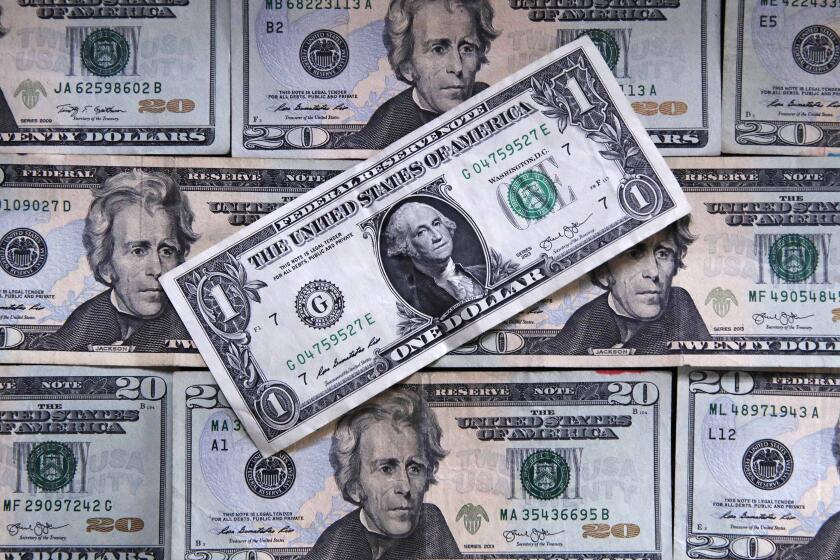401(k) Plans Need a Major Overhaul
- Share via
WASHINGTON — Chalk it up to confusion. Enron employees at the bottom of the corporate totem pole can be forgiven for being gullible enough to buy piles of company stock for their 401(k) savings accounts. They, along with many outside investors, were misled. But now comes word that Kenneth L. Lay, the company’s former chairman and CEO, also may have been taken in: He apparently was buying Enron stock as recently as August. The firm went bankrupt in December.
That most inside the company were putting too many eggs in Enron’s basket isn’t surprising. Studies show that workers invest, on average, approximately one-third of their 401(k) pension savings in the company that employs them and sometimes quite a bit more. UCLA economist Shlomo Bernartzi, for example, has found that plans like Enron’s, which match some portion of worker contributions with employer stock, tend to hold about 48% in the company’s shares.
In case anybody forgot, Yale University’s James Tobin won a Nobel Prize in 1981 for confirming one of the greatest investment principles of all time: People need to spread their savings over a broad market portfolio. Those who don’t much care for the rough and tumble on Wall Street should not invest in fewer stocks, Tobin argued. They should put less money into their broadly diversified portfolio and more into completely safe investments like U.S. Treasury bonds.
So, why don’t folks diversify enough? Investors find it reassuring to put their money into familiar companies, and the firm that’s most familiar of all is their employer. Bernartzi’s research shows that workers take it as a cue that employer stock represents a good investment when the company contributes shares to their plans. Nothing could be further from the truth in far too many cases. Buying employer stock also can become a loyalty test, if workers think that they can impress the boss or somehow avoid trouble by owning a piece of the company.
The view from Washington has been equally murky. Officials never have been able to bring themselves to treat 401(k)s as retirement plans. The government, instead, likes to think of them as profit-sharing plans. Yet, 401(k)s have become the primary retirement vehicle for almost 17 million people and, together with similar arrangements, now cover about twice as many active workers as traditional retirement plans that pay a monthly pension based on earnings and length of service to a single employer. The newer defined-contribution plans--401(k)s and others like them--also have more assets.
It all began when the Employee Retirement Income Security Act (ERISA) first allowed companies to set up 401(k)s in 1974. That law also revamped traditionally defined benefit pension plans after a string of bankruptcies left many workers in those plans high and dry. ERISA placed a 10% cap on “party-in-interest investments”--employer stock and other securities issued by the company or its affiliates--that traditional plans could hold.
The rules now say that employers can’t force their workers to hold more than 10% of their 401(k) money in company stock. But the sky is the limit on how much company stock workers “voluntarily” can put into their 401(k)s. Most companies, including Enron, bar sales of the stock they use to match worker contributions, at least until the worker reaches the age of 50.
Washington has seen this movie before. A string of scandals over the years led to repeated calls to cap employer stock in 401(k)s. Alarm bells went off after workers took big hits at companies like Rite Aid, Morrison Knudsen Corp., Columbia/HCA Healthcare Corp., Color Tile Inc., McKesson Corp., Ikon Office Solutions Inc. and, more recently, at Lucent Technologies Inc.
Companies may want to give their workers a piece of the action for understandable reasons. Holding company stock, after all, could make them better employees. But a primary pension plan is not the right place for that. Congress gives up lots of tax revenue to encourage companies to offer 401(k)s. If the purpose has become to provide workers with a financially secure retirement, officials need to face that fact, and higher standards of safety should apply.
There’s a deeper problem. America’s financial markets are reputed to be unmatched in their ability to channel capital to its most productive uses. The rest of the world is voting with its pocketbook. Trillions in foreign capital has been flowing to our shores for more than a generation, and many countries are trying to imitate the U.S.-market model.
But the Enron fiasco, in part, directly threatens that incredibly successful system. Holding vast amounts of company stock in private pension plans traps that capital inside one firm. So, a big portion of America’s retirement savings can’t flow to the best investment opportunities available. That’s what Enron’s 401(k) and all party-in-interest investments are really about: blocking the natural flow of capital to its most productive uses. This and less extreme examples not only can rob workers of a decent retirement, they also can shortchange the rest of us. Our economy could produce lots of extra things if more of America’s retirement savings were unleashed on truly promising new investments.
Several European countries have relied on systems that pour workers’ retirement money into party-in-interest investments. Germany, Sweden and Finland are among them, and they have paid a price. Their stock markets--relative to the size of their economies--are puny compared with ours. These countries now are recognizing the error of their ways and recently set out to repair the damage with tax changes and other reforms.
Here at home, Washington has its work cut out for it. Party-in-interest investments are also conflict-of-interest investments: a license for companies to misdirect and even squander whatever retirement money goes into them. The proposals under consideration in Congress don’t look so good against this backdrop. Sens. Jon Corzine (D-N.J.) and Barbara Boxer (D-Calif.) want to cap employer stock in 401(k)s at 20%. Reps. Peter Deutsch (D-Fla.) and Gene Green (D-Texas) would hold the limit to 10%. And the Bush administration faces an unhappy choice between its justified preference for the marketplace and its many friends in the business community who, oddly enough, fiercely oppose change in this area.
The Enron debacle has obscured some basic truths about today’s 401(k)s. They can deliver modern pensions that travel well and retain their value when workers move from job to job. And they also let workers choose the level of investment risk in keeping with their needs. But 401(k)s come with one tragic flaw and Washington doesn’t seem to have a clue about how to fix it. This is no time for more confusion.
More to Read
Inside the business of entertainment
The Wide Shot brings you news, analysis and insights on everything from streaming wars to production — and what it all means for the future.
You may occasionally receive promotional content from the Los Angeles Times.










